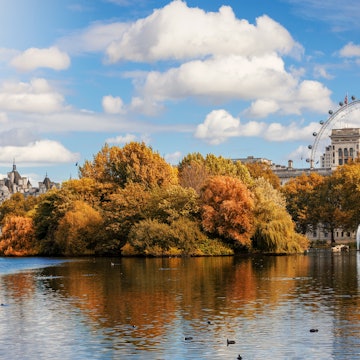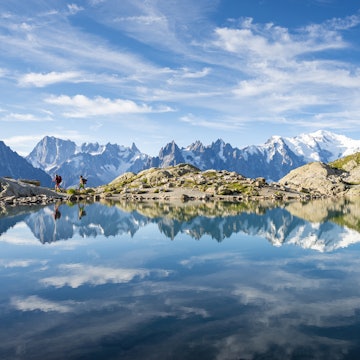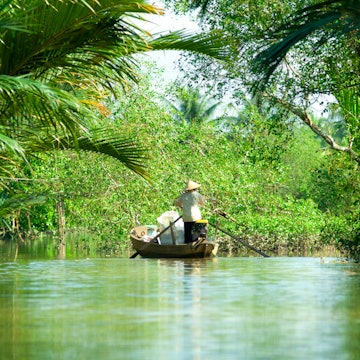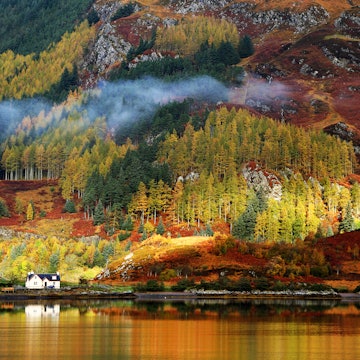
The 8 best national parks in France: from untouched wildernesses to spaces under three hours from Paris
Aug 9, 2022 • 11 min read
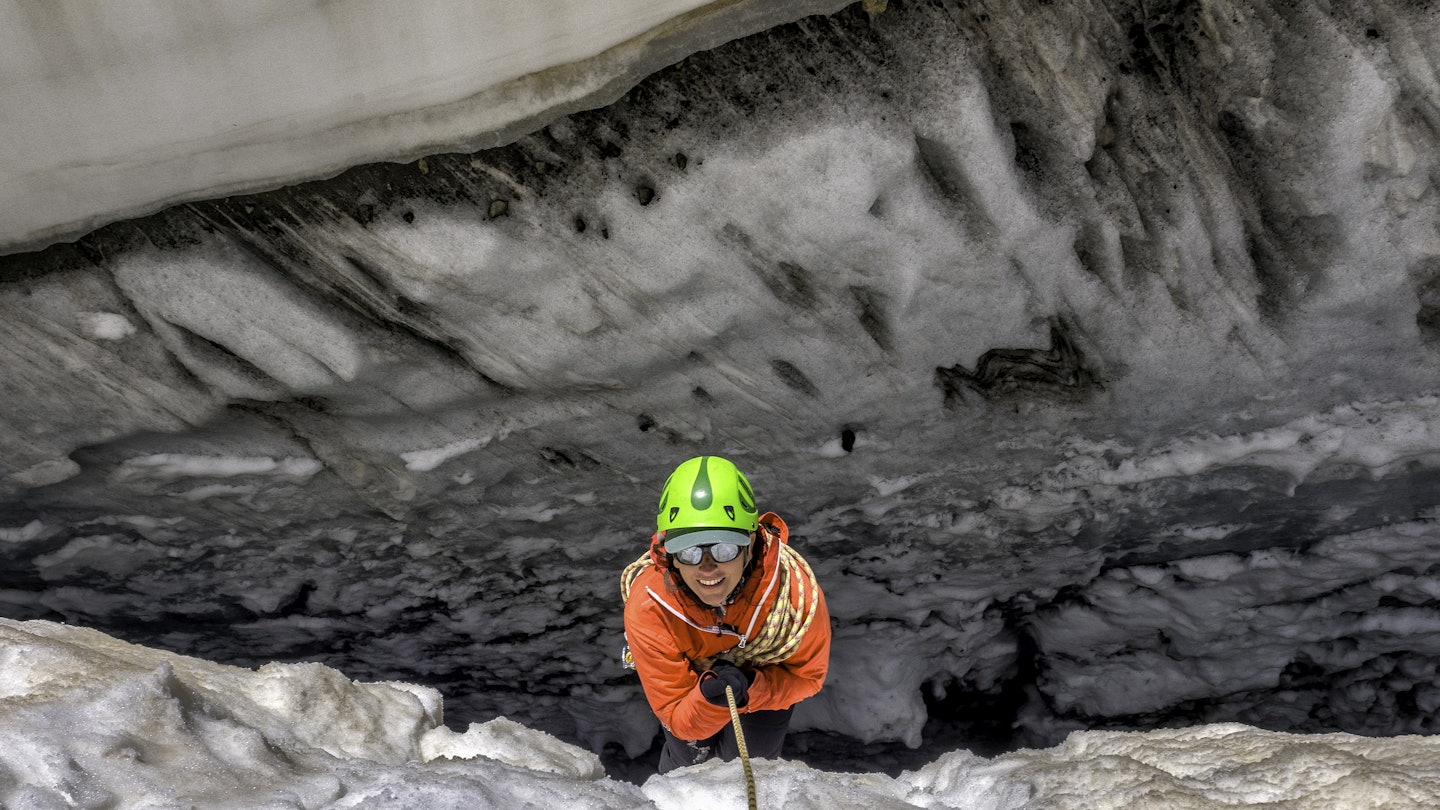
Climbing in the thrilling Écrins National Park © Westend61 / Getty Images
From snowy mountains to dense forests, sprawling vineyards to sparkling coasts, France is famous for its landscapes, and the French place a correspondingly high value on protecting the natural environment – as well as on getting out and enjoying the great outdoors.
Since the 1960s, France has established eight national parks (along with another three in French overseas territories) alongside a wealth of parcs naturels regionaux (regional nature parks) and réserves naturelles (nature reserves).
Collectively, they were established to protect France’s precious wild places and provide a vital refuge for all kinds of rare plants, birds and animals – as well as supporting things such as local culture, architecture, heritage sites and traditional crafts. Some areas are untouched wildernesses while others are surprisingly close to big towns and cities. Hike to a mountain refuge, snorkel in the Mediterranean, canoe down a wild river or trek on horseback through an ancient forest; France's parcs nationaux are primed for adventure.
How much does it cost to visit the national parks in France?
There is no admission fee for any of France’s national parks, but you’ll often find that accommodation and activities in and around the parks tend to be more expensive than elsewhere. Peak season is during the French grandes vacances in late July and August when the parks are at their busiest and accommodation is tough to come by, so visit during spring or autumn to avoid the crowds.

Explore the Alps in Parc National de la Vanoise
The oldest of the three national parks studding the French Alps, the Parc National de la Vanoise was established way back in 1963 and, in many ways, set the framework for the French national park system. Its goal was to protect the delicate alpine environment surrounding the neighboring Tarentaise and Maurienne Valleys, an area of 529 sq km that includes more than a hundred 3000m-high mountains and sits alongside some of France’s most popular ski areas (including Tignes, Val d’Isère and the legendary Trois Vallées). Sharing a border with the Gran Paradiso National Park in Italy, Vanoise forms one of the largest protected mountain landscapes in Europe.
As you’d expect, winter sports are hugely popular here. It’s a great place to try the unusual outdoor pastime of raquette à neige (snowshoeing). In summer, once the snow melts, it’s equally popular for hiking and mountain biking. Rando.Vanoise.com has an excellent selection of hikes with full topographical maps that can be downloaded as GPS files. Bring binoculars if you want to be in with a chance of spying on France’s largest colony of bouquetins (Alpine ibexes), which number around 1800. They roam around the upper slopes of the mountains, where they’re famously tricky to spot.

Follow shepherds’ trails in Parc National des Écrins
At 925 sq km, France’s second-largest national park sits southwest of Vanoise, roughly bordered by the mountain towns of Bourg d’Oisans, Briançon and Gap. Like Vanoise, this is definitely a park for mountain lovers. More than 100 peaks sit within its borders, including France’s second highest summit, the imposing Barre des Écrins (4102m). Its steep-sided valleys were carved out by glacial action, and there are still more than 40 ice sheets to see, although – thanks to climate change – they are getting smaller with every passing year.
Écrins is probably the park most favored by serious hikers. It’s as close to wilderness as the French Alps gets, with just a single inhabited hamlet, Dormillouse. Several nature reserves are entirely off-limits to human visitors. Some 700km of marked trails wind their way around the park, many of which have been trodden by local shepherds for centuries.
High-altitude refuges (mountain huts) enable you to embark on some epic long-distance treks; if you have a booking, you’re guaranteed a space to sleep and, at some huts, a hot meal cooked up by the hut warden. There are some classic French hikes to tackle in Parc National des Écrins, notably the Glacier Blanc, the high-level trek from the village of Dormillouse, and the summit of Barre des Écrins.

Spot wild eagles, wolves and ibex in Parc National du Mercantour
For most people, Provence conjures visions of pastoral France: sleepy hilltop villages, fields of lavender and fishing villages. But inland from the coast, Provence flanks the Alps, and many visitors are surprised to discover just how wild and rugged Haute-Provence becomes.
Much of this mountainous part of Provence is contained within the borders of the Parc National du Mercantour, a vast 685 sq km area that takes in spiky peaks, steep valleys, remote mountain villages and even a handful of glaciers (it’s also home to the Cime du Gélas, which at 3143m is the third-highest mountain in the Alpes-Maritimes).
Like the other mountain parks, Mercantour changes character according to the season. Blanketed by snow in winter, the park basks in Provençal sunlight from around May to September, which makes it brilliant for summer hiking. Unlike other Alpine parks, much of it is accessible by road – although some of the hairpin turns are pretty hair-raising, so be prepared. If you don’t fancy driving, another option for exploring the park is the picturesque Train des Pignes (Pine Cone Train) – a delightful 151km-long railway line from Nice to the mountain spa town of Digne-les-Bains.
Mercantour is a super park for wildlife spotting. With luck, mouflons, chamois, ibex, golden eagles and even rare bearded vultures can all be seen here. Controversially, Mercantour is also one of the parks where wild grey wolves have been allowed to re-establish themselves, much to the fury of local farmers and shepherds. You’re extremely unlikely to see them in the wild, though you can see them up close at the Alpha wildlife park near St-Martin-Vésubie.
Another unique sight is in the Vallée des Merveilles, where over 36,000 ancient stone carvings are engraved into the rocks, the oldest of which were created more than 1800 years ago.

Seek out secret beaches in Parc National des Calanques
While the sun-seeking hordes flock to the beaches of the Côte d’Azur in summer, locals and savvy visitors head to the much craggier, more inaccessible beaches of the Calanques – the area of high, rugged cliffs that extends southeast from Marseille. Composed of a network of steep-sided canyons which have been carved out over countless millennia by weather, geology and time, the Calanques also offer access to some of the loveliest coves on the southern French coast: patches of white sand with water of a blue so vivid you’ll hardly believe your eyes. For many years the Calanques were well off the radar, but since 2012 they have been officially protected as the Parc National des Calanques.
It’s worth noting that while beautiful, many of the Calanques are relatively inaccessible. Getting to the more remote ones often involves a steep, sweaty trek along narrow trails where it’s easy to turn an ankle, and the summer sun can be punishing. The most famous is Calanque d’En Vau, a cove so perfect it's featured on many a local postcard. Port-Miou and Port-Pin are also worth seeking out, while Calanque de Morgiou is one of the few you can drive to (albeit along a rollercoaster of a road).
Go canoeing and caving in Parc National des Cévennes
The lush, forested hills of the Cévennes receive fewer visitors than many of France’s better-known national parks. The exception is high summer, when the narrow roads along its wondrous gorges, like the Gorges du Tarn, are nose-to-tail with traffic (visit in spring or autumn to see the Cévennes at its best).
Heavily wooded with old-growth oak, beech and sweet chestnut, the Cévennes mountain range is an important bank of biodiversity, as recognized by its status as Unesco Biosphere Reserve: 2300 plants and 2410 animals have been recorded here — more species than anywhere else in France.
It’s a popular area for canoeing and rafting, with lots of guide services around the villages of Sainte-Enimie and La Malène offering guided trips (like Locanoë). If you don’t feel like getting wet, you could just hit the trails instead. The Cévennes is famously featured in Robert Louis Stephenson’s 1878 travelog, Travels with a Donkey in the Cévennes. The long-distance GR70 (a.k.a. The Chemin de Stevenson) traces his route across the park. Trekking at least a section of it is a must if you’re visiting – as is a stop at the Mont Aigoual Observatory, which offers panoramic views over the national park.
Higher up, the woods and canyons of the Cévennes give way to an entirely different – and altogether stranger – landscape known as the causses. Barren, windswept and largely devoid of vegetation, these eerie limestone plateaus form part of a Unesco World Heritage Site, Causses et Cévennes. Underground, they also conceal some of France’s most extensive cave systems, several of which can be visited – like Aven Armand and its cathedral of stalactites and stalagmites.
Hike the peaks in Parc National des Pyrénées
If it’s more mountains you’re after, you’ll find them in abundance in southwestern France – only without the glitz and glamour of the Alps. While there are some small ski resorts here (notably around Cauterets), the French Pyrenees feel like a much more traditional corner of France, where mountain agriculture and rural life continue in much the same way as they have for centuries. Shepherds move their flocks up and down every spring and autumn from the lush mountain pastures in an age-old ceremony known as transhumance.
If you want to see traditional mountain life, this is definitely where to come. The Pyrenees are dotted with quiet villages and small rural towns where you can truly immerse yourself in local life (they’re also one of the only places in France where wild brown bears still roam, albeit reintroduced from eastern Europe).
There are six main valleys within the national park: Vallée d’Aspe, Vallée d’Ossau, Vallée d’Aure, Vallée de Luz, Vallée de Cauterets and Val d’Azun. The surrounding mountains are crisscrossed by trails, including the long-haul GR10 and several others which travel over the border into Spain. Among the most spectacular walks is the trek to a trio of stunning natural amphitheaters – Cirque de Gavarnie, Cirque du Troumouse and Cirque d’Estaubé – where ancient glaciers have carved out huge, breathtaking bowls from the mountains. The hike to Lac de Gaube via Pont d’Espagne from Cauterets is another very popular route.

Go snorkeling in Parc National de Port-Cros
France’s only island park covers a large area of the Îles d’Hyères, the small archipelago of islands that sits off the south coast near Toulon. Affectionately known to locals as the Îles d’Or (Golden Isles), this is also the only French national park that encompasses both land and sea: 1700 hectares of island (mainly on the big isles of Port-Cros and neighboring Porquerolles), along with another 2900 hectares of marine habitat, extending out 600m from the coast.
Lightly wooded and sparsely populated (and in Port-Cros’ case, car-free), the islands are brilliant for exploring by bike or on foot. Their abundance of small beaches and coves are fantastic for snorkeling, so it’s worth packing a picnic and plenty of water. You can also organize diving trips if you’re up for going deeper or boat trips to explore the coast. Note that there's nowhere to pick up supplies beyond the islands’ little ports. Regular ferries run across from the harbor at Toulon.
Parc National de Forêts
Established in 2019, this newcomer marks a departure for the French national park system: less wild, much more accessible (just three hours or so from Paris) and nowhere near any mountains or sea. It spans a large area of Burgundy and Champagne, with lots of little villages and towns dotted around its borders, alongside marshland, rivers and, of course, some vast woods (roughly 500 sq km of them, including crown jewels like the Forêt de Chantilly and Fôret d’Arc-en-Bois, which collectively contain around 50 million trees).
Various trails have been established around the park, allowing visitors to explore on foot, by bike or, perhaps loveliest of all, on horseback – a fitting way to get around, considering that historically, much of this area would have been the preserve of French nobles hunting for wild boar, deer and other forest creatures. Most unusual are the cigognes noires (black storks) who migrate here from Africa to make nests at the top of hundred-year-old oaks. It’s worth looking down as well as up: Many rare mosses, lichens and woodland wildflowers thrive here, including the ultra-rare Venus slipper orchid (fine for picking: a cool €15,000).
In many ways, this is a cultural park as much as a natural one, celebrating the traditions and rural life in France profonde: local craftspeople, food producers and winemakers have been an essential part of life here since the Middle Ages, and their skills are still highly valued. Don’t miss the chance to go on a guided hunt for truffes noires (black truffles); these prized mushrooms thrive on the roots of old oak trees, but you’ll need local knowledge (and a well-trained truffle hound) for a chance of finding one.






